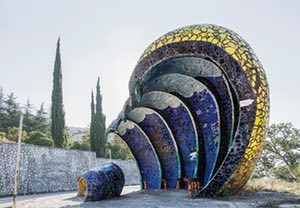There are not a lot of words in this book of photography, and the subject is laid out right there in the title. Soviet Bus Stops sounds like it could be terribly dry, almost a parody of narrow history, but no, it’s a glimpse into an interesting and vanishing world.
Photographer Christopher Herwig bicycled from London to St Petersburg in 2002 “with the challenge of taking one good photo every hour.” (p. 9) He noticed details. Beginning in 2003, he lived for three years in the ex-Soviet republics of Central Asia. He found what was expected, but also “eccentricities that defied Soviet conventions.” (p. 9) He noticed bus stops in particular:
In Canada, where I come from, bus stops are all the same. But in the former Soviet republics, many were unique, imaginative, and sometimes a bit mad. … Behind the Iron Curtain were millions of individuals who liked to daydream, wanted to push the limits of creativity and needed a way to share it. (p. 9)
As part of the introductory material, Vera Kavalkova-Halvarsson explains part of how these oddities came about. One architect from Belarus who designed nearly 100 “bus pavilions,” as they were known, says that tight regulation, limited technology and competition for major projects meant that there was very little room for creativity. Artists seized whatever opportunities were available, even a humble bus pavilion. “Designing a bus stop was often one of the first independent projects assigned to students of architecture departments. Students were encouraged to produce designs never seen before.” (p. 11) Limited budgets, often about one-third the cost of a car (p. 14), meant that designers and artisans had to be creative to do anything different, but the small scale also meant that bureaucrats with stifling rules did not pay attention to such minor matters.
In very small villages or remote locations, though, they were not minor matters at all. Bus links were crucial connections to the larger world. “The bus stop was a public space and could be used to bring art to the people and to brighten up the surroundings. (p. 12)
After a dozen pages or so of introduction, the rest of the book is given over to photographs of these unusual artifacts. Some are whimsical, like the stop in Kyrgyzstan that’s shaped like a local traditional hat. Some may have double meanings, like the mural of agricultural combines whose silhouettes could be mistaken for rows of tanks. Some are poignant in new ways, like the one shaped like a light house, in a desert near where the Aral Sea used to be. There are giant waves or clam shells from the Black Sea coast, there are abstract crowns in Armenia or yurts in Kazakhstan. There are unexpectedly colorful mosaics from Ukraine. The pavilions from the Baltic republics look like EU money has recently been invested in their upkeep. The poverty of other republics can be seen in the stops’ state. Russia is conspicuously absent from this survey (Azerbaijan does not appear either), and the author does not mention any reason for this choice. On the whole, though, it’s a very interesting glimpse of how much an unregarded object can reveal.




1 comment
The one thing I would point out to the author, there is one type of bus stop in Canada that is not necessarily the same- go out to the country and you will see the little shed bus stops families created for their kids to wait for the school bus in the winter. Some of them are just shelters while another’s are homey or fun. I don’t remember individuals anymore- but I remember wondering “wth?” At times until I realized they were school bus stops.